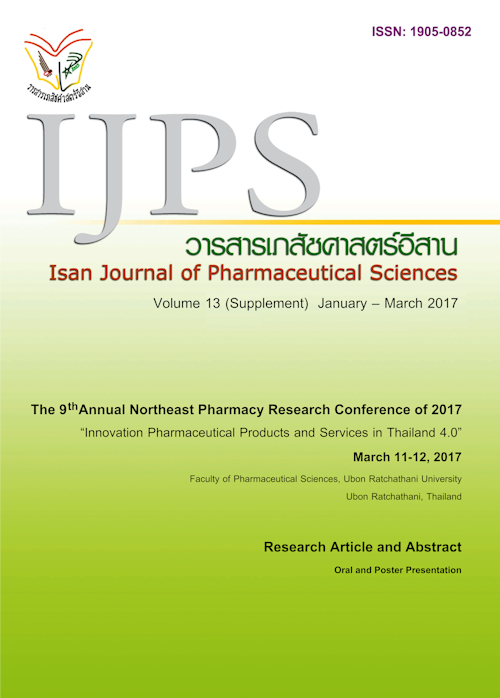Effect of oil, water and surfactant mixture on the physicochemical properties and transdermal delivery of finasteride-loaded microemulsions: evaluation and prediction using response surface methodology
Main Article Content
Abstract
Introduction: Finasteride is an effective drug for the treatment of androgenetic alopecia by inhibition of type II 5α- reductase. However, oral administration finasteride has the undesirable systemic side effect about sexual dysfunction. Therefore topical delivery system of finasteride is a method to avoid this problem. Microemulsion (ME) is an interest delivery system for delivery of finasteride through the skin. The objective of this study was to investigate the effect of oil phase, water phase and surfactant mixture (Smix: surfactant and co-surfactant) on the physicochemical properties of finasteride-loaded microemusion. Methods: The pseudoternary phase diagrams were constructed to obtain the microemulsion area. Then the seven different ratios of microemulsion were selected to evaluate the physicochemical properties (droplet size, size distribution, conductivity and pH) by comparing between blank and finasteride-loaded microemulsion. The response surface method was used to predict the results by using computer program. The three finasteride- loaded microemulsion formulations with the same percentage of surfactant mixture were selected to study the in vitro skin permeation. Results: The pseudoterary phase diagram of microemulsion system with Smix at ratio 3:1 showed the largest area of microemulsion, therefore this system was selected to incorporate finasteride into the formulation. Finasteride did not affect the change in physicochemical properties of microemulsion. The in vitro skin permeation results indicated that the formulation with high concentration of water showed higher permeation flux than the formulation with low concentration of water. Conclusion: The prediction of finasteride-loaded ME by using response surface methodology showed the relationship between the amount of the composition in ME formulation and the physicochemical properties. This suggested that the optimal formulation can be developed for transdermal delivery of finasteride in treatment of androgenetic alopecia. However, other properties of the formulation, such as entrapment efficiency, skin retention, toxicity and stability of the formulation should be investigated.
Article Details
In the case that some parts are used by others The author must Confirm that obtaining permission to use some of the original authors. And must attach evidence That the permission has been included
References
Bhatia G, Zhou Y, Banga AK. Adapalene microemulsionfor transfollicular drug delivery. J Pharm Sci. 2013; 102(8): 2622-31.
Biruss B, Kahlig H, Valenta C. Evaluation of an eucalyptus oil containing topical drug delivery system for selected steroid hormones. In J Pharm. 2007; 328: 142-151.
Caon T, Porto LC, Granada A, Tagliari MP, Silva MA, Simoes CM, et al. Chitosan-decorated polystyrene-b-poly (acryliacid) polymersomes as novel carriers for topical delivery of finasteride. Eur J Pharm Sci. 2014; 52: 165-72.
Duangjit S, Chairat W, Opanasopit P, Rojanarata T, Ngawhirunpat T. Application of De-sign Expert for the investigation of capsaicin-loaded microemulsions for transdermal delivery. Pharm Dev Technol, 2015; 21(6): 698-705.
Jaipakdee N, Limpongsa E, Pongjanyakul T. Optimization of minoxidil microemulsion using fractional factorial design approach. Pharm Dev Technol. 2014; 1-12.
Kogan A, Garti N. Microemulsion as transdermal drug delivery vehicles. Adv Colloid Interface Sci. 2006; 123-126: 369-385.
Kumar R, Singh B, Bakshi G, Katare OP. Development of liposomal system of finasteride for topical applications: Design, characterization, and in vitro evaluation. Pharm Dev Technol. 2007; 12(6): 591-601.
Liu S, Yamauchi H. Different patterns of 5α-reductase expression, cellular distribution, and testosterone metabolism in human follicular dermal papilla cells. Biochem Biophys Res Commun. 2008; 368: 858-864.
Madheswaran T, Baskaran R, Thapa RK, Rhyu JY, Choi HY, Kim JO, et al. Design and in vitro evaluation of finasteride-loaded liquid crystalline nanoparticles for topical delivery. AAPS Pharm Sci Tech. 2013; 14(1): 45-52.
Maghraby GM. Transdermal delivery of hydro-cortisone from eucalyptus oil microemulsion: Effect of co-surfactants. Int J Pharm. 2008; 355: 285-292.
Monti D, Tampucci S, Burgalassi S, Chetoni P, Lenzi C, Pirone A, et al. Topical formulations containing finasteride. Part I: in vitro permeation/penetration study and in vivo pharmacokinetics in hairless rat. J Pharm Sci. 2014; 103(8): 2307-14.
Ngawhirunpat T, Worachun N, Opanasopit P, Rojanarata T, Panomsuk S. Cremophor RH40-PEG 400 microemulsions as transdermal drug delivery carrier for ketoprofen. Pharm Dev Technol. 2013; 18(4): 798-803.
Saraswat A, Kumar B. Minoxidil vs finasteride in the treatment of men with androgenetic alopecia. Arch Dermatol. 2003; 139: 1219-1221.
Shah RR, Magdum CS, Patil SS, Niakwade NS, Preparation and evaluation of aceclofenac topical microemulsion. Iranian J Pharm Res. 2010; 9(1): 5-11.
Tabbakhian M, Tavakoli N, Jaafari MR, Dane-shamouz S. Enhancement of follicular delivery of finasteride by liposomes and niosomes 1. In vitro permeation and in vivo deposition studies using hamster flank and ear models. Int J Pharm. 2006; 323: 1-10.
Rao Y, Zheng F, Liang X. Penetration profile and human cadaver skin distribution of finasteride from vesicular nanocarriers. Drug Deliv. 2015; 22(8): 1003-9.


